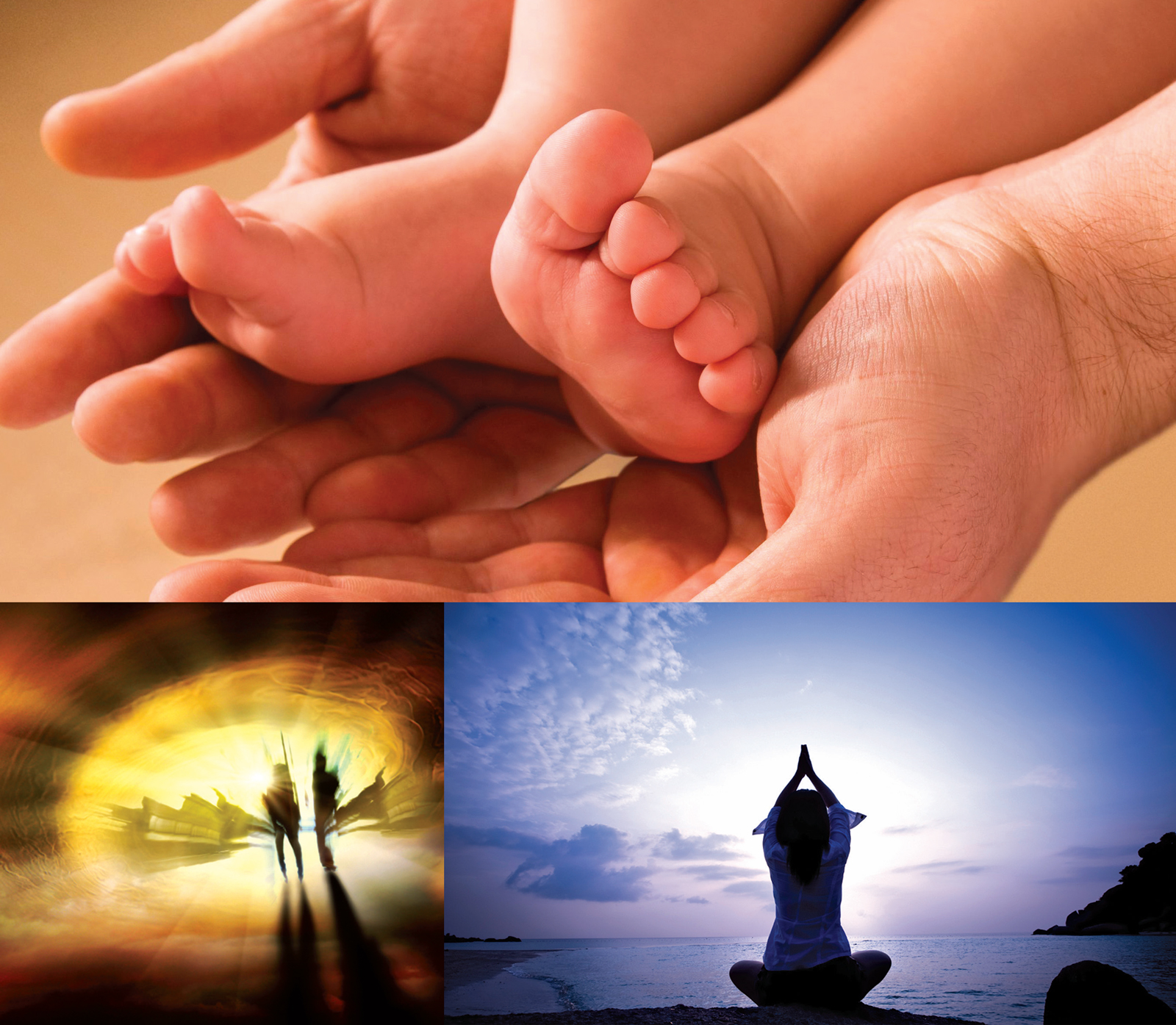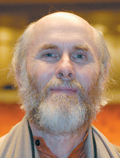The quest for immortality has been the ultimate concern of all human beings since the beginning of time. We all naturally want to live forever and never die. Whatever may be our other pursuits in life for wealth, fame, knowledge or happiness, whether we attain them or not, a greater seeking for immortality remains in the background waiting for us to take it up as our highest goal. We all strive for meaningfulness, especially in old-age when we’ve given up work; it is important not to lose sight of things that give us purpose and to make the most of your golden years.
This desire for deathlessness, however, is no mere hope, fantasy or delusion. It reflects the innate urge of the immortal soul hidden within us, which itself is never born and never dies. In our inmost being, we are one with the eternal and infinite and maintain a deep wish to return to it as our true home. Our physical life journey must eventually cause us to recognize this greater spiritual origin and goal. Our longing for immortality is an indication of our deeper Self and essence that we can never forget, which dwells far beyond the travails of this mortal realm.
At the same time as much as we wish for immortality, we have an equally deep fear of death. Death appears as the great barrier for all things in our lives, the end of all that we can do in this world and all that we hold dear within it. We innately sense that there is something unnecessary about death, which holds the tragedy of human existence, and calls into question our entire outer reality. We cannot accept death as final, and sense something greater within us beyond its grasp.
Yet we observe that each creature that is born grows old and eventually dies in the inevitable course of time. Infancy turns into youth, then into maturity, decline, debility and finally complete cessation of life for all creatures. We watch our pets and our parents grow old and die, and then experience it for those of our own generation and for ourselves. The aging process appears as the great leveler in life, affecting equally the rich and the poor, the famous and the ordinary. The relentless ticking of our biological clock seems to rule over all else that we do with an imperial and unbending force.
Certainly, we see people who live longer and age better than others, maintaining health, intelligence and happiness well into their later years. Such long-lived individuals represent another desirable goal of life, which is longevity, but they still stand on this side of death, compared to which even a long life is but a short episode in the enduring world of eternity. Longevity, however helpful, is not enough to take us beyond death.
Realizing the inevitability of death, we have sought to create or to discover another life beyond the demise of the body. We pass down our wisdom and belongings in an effort to at least leave a lasting legacy. Most of what we call religion has arisen to deal with the issue of death and offers some continued existence beyond the limitations of our earthly life. Religion has envisioned an afterlife in various forms; sometimes a resurrection of the physical body in a heavenly world where it will not die again, or gaining an immortal subtle body of light or energy that unlike the physical body does not need to die. Religion tells us that through faith, belief and good works we can be led to such a greater life after death, as a reward for our good thoughts and actions here.
On the other hand, deeper spiritual and mystical teachings, particularly the great meditation traditions of Asia, emphasize an immortality of consciousness not only beyond the mortality of the physical body, but beyond any type of creaturely existence in this or in subtler realms. They teach that our own inner essence exists not only beyond death but also beyond birth, ever free of limitation to body or form in this world or another. We can take birth in any number of bodies and, more importantly, we can reach a state in which we no longer dwell in time and its limitations, and are under no compulsion to be born again.
Yet whatever our spiritual background or our religious views, we all want to live longer, if not go beyond death altogether. The quest for immortality therefore has two levels, outer and inner, physical and spiritual.
-
- The first or outer aspect of the quest for immortality is rejuvenation of the body and mind, which includes the promotion of physical longevity.
- The second or inner aspect is immortality of the spirit or consciousness, which can include the continued existence of a subtle mind or astral body.
Physical immortality, rejuvenation and longevity
The question then arises: “Is physical immortality at all possible?” There are indications in the yoga tradition of India that a few rare individuals have achieved if not physical immortality, at least great longevity extending through many ordinary human lifetimes. Various mystical and esoteric traditions suggest the same, such as the long-lived prophets of the Bible or the Taoist immortals of ancient China. The Vedic rishis of India were said to have lived for very long periods of time, extending into the centuries, through accessing the power of Soma, a special energy connected with the healing forces of nature and the inner powers of the psyche arising from special yoga and meditation practices. Hindu thought mentions various chiranjivas, or long-lived sages, some of who are said to be still alive. There are other traditions of immortal ascended masters, though sometimes their immortality is said to be in a subtle, not a physical body, or only accessible to those of a certain purity of mind and heart. While there are often a number of fantasies and illusions associated with such ideas, there seems to be a core of truth behind them as well.
Classical Tantric Yoga – which teaches us to work with the secret energies of nature like the Kundalini – has developed special outer methods of extending physical longevity, including the use of powerful herbs, minerals, gems, and elixirs, much like other alchemical traditions worldwide. These are combined with special inner Tantric Yoga practices of Pranayama, mantra, and yantra and working with the deities and powers of nature in a precise spiritual science of inner transformation to take us beyond our ordinary human limitations.

Probably the most famous yogic case of physical immortality is that of Mahavatar Babaji, the immortal Himalayan Yogi introduced to the world by Paramahamsa Yogananda, one of his disciples, in Paramahamsa Yogananda’s classic Autobiography of a Yogi. Babaji and his female companion Mataji are said to live in yogically energized immortal physical bodies in special retreat areas of the high Himalayas above Badrinath along with a select group of disciples, some of which have also taken on undying physical bodies themselves.
However, such yogic achievements of physical immortality are so extremely rare as to be for all practical purposes impossible for the ordinary human being. They rest upon a special birth in yogic families in the Himalayas after an exalted spiritual birth that took one to the highest spiritual realization already, not on any ordinary human birth. They involve a pure diet and environment, and special yogic practices from birth along with these great masters. There is no reason for us to think that such a physical immortality is possible for us, or even desirable for the type of mentality that we have in the world today.
It is mainly in the Integral Yoga of Sri Aurobindo – one of the greatest spiritual masters and visionaries of modern India, that one finds a clear and specific discipline designed to develop physical immortality, which is addressed in great depth and detail in his voluminous and profound writings. However, in Sri Aurobindo’s Integral Yoga, physical immortality is not the prime concern but only the ultimate highlight, following a comprehensive yogic development of a deeper devotion and awareness within us.
Moreover, Aurobindo approaches the immortalization of the physical body not as a personal achievement for furthering our mundane desires, but as part of a long-term evolutionary process for developing a higher type of human being, if not a higher species altogether. It is not physical immortality for the ordinary person that Aurobindo seeks but that of the realized soul, who has transformed the mind and emotional nature. He realizes that the current human being with its various negative karmic and genetic influences requires a considerable recasting before it is worthy of a prolonged existence or can naturally hold a higher consciousness.
A physical longevity of a hundred years should be the norm for human beings if we live a healthy natural life in a clean natural environment, even longer if we are doing yoga practices. The fact that we do not have such longevity is a sign of an unhealthy lifestyle on our own part or an unhealthy culture.
Aurobindo aims at a long-term, if not millennial creation of a new spiritual being on Earth, not just making existing humans live longer or avoid physical death such as we are in our current undeveloped states of awareness and intelligence. It is an evolutionary goal of the species that he seeks, which we can individually help prepare the way for, but are quite unlikely to attain personally. His disciples seek the development of a new humanity, not simply their own longer physical existence. Moreover, his Integral Yoga seeks this transformation of the human being through a new descent of Divine grace or Shakti – the force of the Divine Mother – not simply through outer methods of diet, herbs or yoga techniques, much less scientific or genetic breakthroughs. It rests upon awakening to and surrendering to that descent of grace from above, which has its own powers and processes. Aurobindo puts us in contact with this higher evolutionary Shakti that is a powerful Divine force already present in the spiritual atmosphere of the planet.
Yet while physical immortality is nearly impossible, physical rejuvenation is something attainable to some degree for everyone.

One can undergo special yogic and Ayurvedic rejuvenation regimen that can remove years off of one’s biological age and effectively prolong one’s life beyond what would otherwise be achievable. This doesn’t mean that such methods can turn an eighty year old into a forty year old, but it is possible to be happier, healthier and more aware far beyond one’s ordinary age! The body is always rejuvenating itself and replacing its old cells with new. New prana are ever moving through us with every sunrise and sunset. Rejuvenation aims at speeding up this natural process of revitalization, which ordinarily declines with age.
A physical longevity of a hundred years should be the norm for human beings if we live a healthy natural life in a clean natural environment, even longer if we are doing yoga practices. The fact that we do not have such longevity is a sign of an unhealthy lifestyle on our own part or an unhealthy culture. The added complication for any personal pursuit of longevity today is that it is difficult for us as mere individuals to prolong our lives, if our environment and way of life collectively is toxic and unhealthy, which is now the case almost everywhere on the planet.
Physical longevity also has important spiritual implications. Longevity is very desirable for those on the spiritual path because having made the great effort necessary to awaken to one’s higher purpose in life – which is very difficult in any age – one wants a full life in order to progress along it as much as possible. The right pursuit of physical longevity can be a helpful aid to the deeper pursuit of the immortality of the spirit. This is probably its most important value, as a long life without spirituality not only has no real value, but also removes us from the soul that is the very source of life.
Immortality and rejuvenation of the mind
If immortality of the body is nearly impossible, the next question arises whether immortality of the mind is possible? Certainly it is easier to keep the mind young than it is to stop the body from aging. In fact, as we age in our bodies, we often feel younger in our minds – and usually hold a youthful image of ourselves in our minds that no longer corresponds to our outer appearance.

It is possible to have a fresh, clear and youthful mind even in an old and decaying body. We see many elderly people even above eighty years of age with active, creative and cheerful minds, able to excel the young in expression, logic and insight. All of us have encountered such individuals who surprise us by their age. For them age has helped them mature in mind and spirit, the effect of which is more energy and vitality for their inner being.
While the body matures and ceases to grow around the age of twenty-five, the mind usually does not fully mature until around the age of fifty, and can keep growing as long as one is alive. One of the great sorrows of many older people – particularly in this culture that rarely honor its elders – is that though their minds are not old, they are treated according to the condition of their bodies, and their advice accordingly is not heeded. Their wisdom seems lost on the younger generation that does not want to look at inner realities but remains enmeshed in outer sensations.

It is possible to rejuvenate the mind so that an older person can have a youthful and creative mind. However, it is difficult to make the mind young if the mind has already been made old by years of mindless and thoughtless living, in which there is no cultivation of creativity or inner awareness. Yet those who have developed a creative and spiritual mind in their youth can easily maintain it to the end of their lives, and leave this world with full consciousness and no regrets!
Besides maintaining a youthful mind into old age, there is also a search for immortality of the mind, or at least its continuity, beyond the death of the physical body. Many spiritual teachings contain methods to prepare the mind to continue beyond death. The mind’s ability to transcend death is reflected in the phenomenon of rebirth, which depends upon the mind being able to survive death and take on a new body. In the case of ordinary rebirth, the mind falls into a deep slumber and its memories of the previous life are almost entirely lost before awakening in the new life. Yet after following higher yoga practices, one can carry much of one’s mind and intelligence into the next birth and maintain a continuity of awareness after death.
According to yogic thought, the mind is by nature undying, though it does go through phases of manifestation and rest. The mind does not die with the death of the physical body. It simply undergoes a period of withdrawal, followed by a new active phase after awakening in a new body. The inner core mind carries the samskaras or karmic tendencies that propel us from one birth to another. That inner mind survives the death of the body and its tendencies take it on to a new body.
Yet it is only the core of the mind that has this immortality, not our ordinary outer mind and ego, with its personal thoughts, emotions and memories bound to the outer world of the current birth. At the time of death the mind is reduced to its core tendencies, much like the latent state of the mind in the state of deep sleep. The outer aspect of the mind is dissolved and only the inner core of the mind goes on to another birth. This means that the immortality of the mind is limited and broken by the death of the body, hidden by an ignorance that prevents the ordinary person benefiting from it, and making it difficult for them to access past life skills and wisdom. Most of us cannot experience our mind’s greater existence beyond the body because we cannot sustain our awareness after death from one life to another. But it is something that we can learn to develop.
Higher yoga practices allow us to contact the hidden immortality at the core of the mind and gradually spread it to the rest of the mind, making it eventually into a conscious possession of our daily awareness. Great yogis carry their personalities and minds into successive births. We see this also in the concept of tulkus and the reincarnation of the Dalai Lamas of Tibetan yoga. The more evolved a soul becomes, the more it holds its mind and intelligence through the reincarnation process, not losing it at death. For such exalted souls, death and rebirth are like going to sleep at night and waking up in the morning, not any real end or beginning of existence.
Immortality of the spirit, inner being or higher self (Atman or Purusha)
The immortal spirit
Yet besides this ‘broken’ immortality of the mind, there is a deeper unbroken immortality within each one of us. Our spirit or inner being is immortal by nature and exists beyond the phases of withdrawal and manifestation of the mind from birth to birth. Our true Self consists of pure unmodified awareness, immutable, changeless and serene. Our true nature resides in pure consciousness beyond all the shifting currents of time, space and action that we experience through the mind. We can always access this immortality of our inner being even when the body is dying.
The fact is that in our true nature we are not born and do not die, we do not suffer and are ever beyond gain and loss, pleasure and pain, advance and retreat. Death is an illusion of our outer experience through the mind, not an enduring truth of our inmost Self. Death is perhaps the ultimate illusion, whose veil we must rend asunder to find our true reality. It is the body that dies, not us as the masters of the body. This immortality of the Spirit should rule over our entire existence; we should not be mere victims of the ups and downs of the body, mind and senses. We should not be victims of death but use death to take us to a greater awareness.
This immortality of the spirit is absolute, without qualification or diminution. It is there for everyone to experience. It is the ground of experience itself. The mind has only a relative immortality, enduring at its core but undergoing death and withdrawal in its outer layers. Its immortality is enshrouded in ignorance and is not a fact of experience in our lives.
Yet this immortality of the spirit is not without its relevance for the body. The inner immortality of consciousness contains the power to rejuvenate body and mind, should we aim to do that. It is the wellspring of immortal prana or undying life-energy that is ever accessible within our deepest hearts. We all have the power of immortality within us already as the most intimate layer of all that we are. The issue is how to access our immortal consciousness and connect it with our outer nature, particularly to the surface mind where most of us experience life.
Death only affects the body and the mind, which are but the instruments of the spirit, and like any instrument are subject to friction, decay and ultimate destruction. The body is our outer instrument somewhat like our automobile, necessary to take us places in the material world that is the main focus of our outer existence. But the body is not who we really are and its fulfillment is not our true fulfillment. The mind is our inner instrument, something like our computer, necessary for us to deal with information, particularly about the external world. It is crucial for our outer functioning but its fulfillment is also not that of our true nature either. Our spirit or consciousness is the being or person who operates these two instruments and is not limited by their functioning, like the person who operates the car or the computer.

Death is merely the end of the limited outer personality but does not touch the real person in us. Death is just a moment in time in which we transition from one realm of experience to another, nothing more than a doorway. For our inner being, death can be a release from the ego and its endless desires. It is a means of purifying our outer nature so that we can grow more spiritually in another life. As the Bhagavad Gita so eloquently states: “Of that which is real, there is no non-existence. Of that which is unreal, there is no existence.” What is bound by death never truly exists and what is not bound by death can never be killed.

The surest means to go beyond death and gain immortality is simply to rest in our own immortal Self, the core consciousness within us that is the detached witness of all the movements of the body and mind. You are immortal as you are in your inner being and can never fall prey to death or dissolution. This is an eternal truth, not any mere hope or speculation.
We can all breathe a big sigh of relief here, and accept the immortality, peace and transcendence of our inner being, letting go of the entire realm of death. There is nothing holding us back from this except our own reluctance, which is based upon our identification with our surface ego. Such letting go is very difficult to do owing to our deep-seated attachment to the body and mind extending over many lifetimes. Yet there are many tools to help us through Ayurveda, yoga and meditation to make the task easier and quicker.
Adapted from Soma in Yoga and Ayurveda: The Power of Rejuvenation and Immortality (Lotus Press 2012)
 Dr. David Frawley (Pandit Vamadeva Shastri) is regarded as one of the world’s leading experts on Yoga, Ayurveda, Vedic astrology and Vedic philosophy. He is the author of more than thirty books and several courses, published in over twenty languages. He is director of the American Institute of Vedic Studies and conducts special programs and retreats in India. www.vedanet.com
Dr. David Frawley (Pandit Vamadeva Shastri) is regarded as one of the world’s leading experts on Yoga, Ayurveda, Vedic astrology and Vedic philosophy. He is the author of more than thirty books and several courses, published in over twenty languages. He is director of the American Institute of Vedic Studies and conducts special programs and retreats in India. www.vedanet.com







